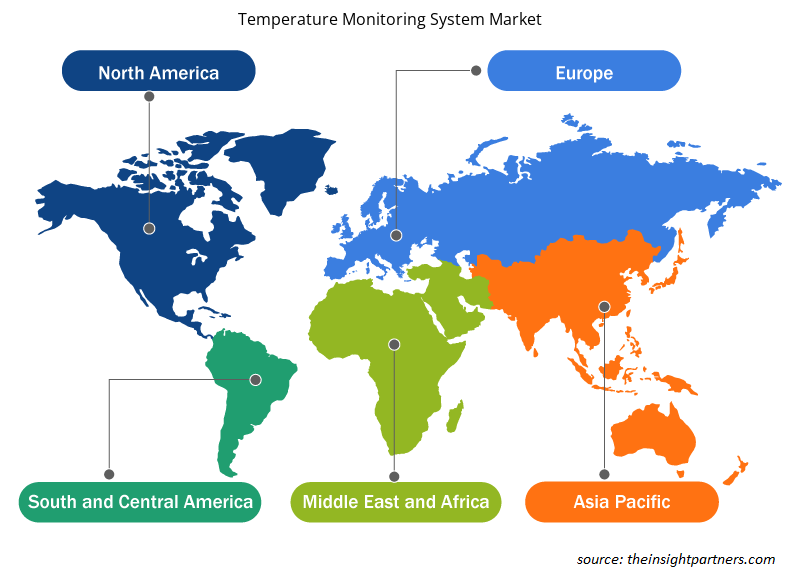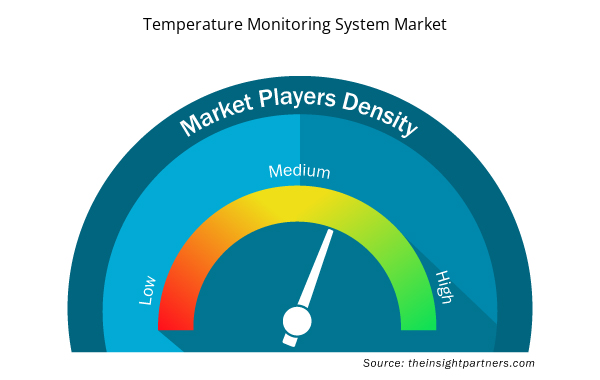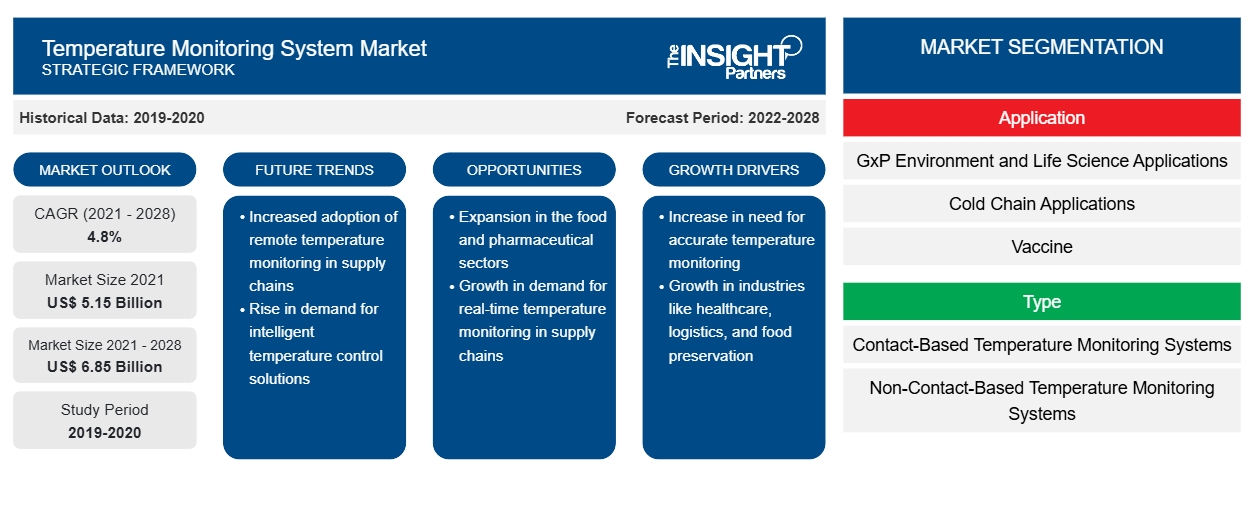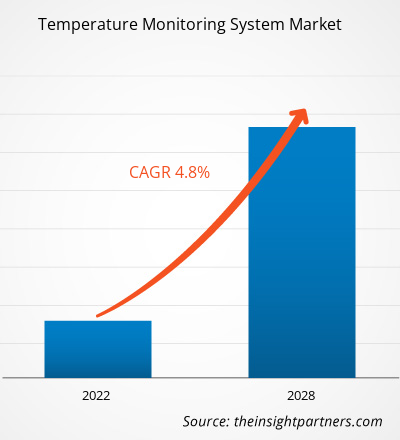温度监测系统市场预计将从 2021 年的 51.5 亿美元增长到 2028 年的 68.5 亿美元;预计 2021 年至 2028 年期间的复合年增长率为 4.8%。
温度监测系统控制和调节特定环境的温度。近年来,温度监测系统已成为医院、诊所、食品企业和其他行业的重要组成部分。借助温度监测系统,人们可以轻松地跟踪、控制和调节特定环境中产品的温度。温度监测系统可确保温度相关产品在运输过程中保持安全。温度监测系统市场根据应用、类型、行业和地理位置进行细分。按地理位置划分,市场大致分为北美、欧洲、亚太地区、中东和非洲以及南美和中美洲。该报告对温度监测系统市场进行了深入分析,强调了市场趋势、技术进步和市场动态等参数,并分析了主要市场参与者的竞争格局。
定制此报告以满足您的需求
您可以免费定制任何报告,包括本报告的部分内容、国家级分析、Excel 数据包,以及为初创企业和大学提供优惠和折扣
- 获取此报告的关键市场趋势。这个免费样品将包括数据分析,从市场趋势到估计和预测。
市场洞察
食品饮料和制药行业的严格监管对温度监测系统市场的增长贡献巨大
与温度相关的问题对制药行业影响巨大。由于合规性、法律法规和环境条件,维持药物和疫苗的效力更加困难。根据美国国家生物技术信息中心 (NCBI) 的数据,2017 年 8 月,一批 100 毫升袋装 Intralipid % IV 脂肪乳剂 (Baxter International, Inc.) 在运往分销点的途中不适当地暴露在低于冰点的温度下——超出了声明的允许储存范围。大约两个月后,制造商自愿召回了这种肠外营养产品,并建议患者丢弃其库存。为了避免此类情况,需要一种有效的温度监测系统来指示系统不一致。制药行业严格的监管要求和指南,如 GMP Pharma、GDP、21 CFR 第 11 部分、GDP Pharma 等,预计将在预测期内推动温度监测系统市场的增长。
对温度敏感的药品在到达最终目的地之前要经过多个阶段和检查,因此在储存和运输过程中,它们容易受到温度、光照、湿度和清洁度等各种环境条件的影响。因此,获得适当的设备和程序来经常监测其温度以确保产品质量不受影响至关重要。在临床前阶段研究的分子或在临床试验期间测试的分子,例如生产和储存阶段的药品(药品、疫苗等),必须作为药品冷链监测过程的一部分进行实时监测。
温度监测是药品质量控制的重要组成部分。使用各种技术监测温度,向系统发出任何异常警报。监管要求适用于旨在进行研究、制造、储存、运输或销售药品的企业。每个国家的法律法规都是独一无二的。它们通常包括国家或国际治理,例如欧盟(在欧洲)、FDA(在美国)或瑞士药品监管局(在瑞士),均由人用药品技术需求国际协调会 (ICH) 授权。
除了官方法规外,一些重要协会还发布了指导文件,支持并详细说明法规及其在特定情况下的应用。与医药供应链行业相关的一些最具影响力的组织包括美国药典 (USP)、国际制药工程学会 (ISPE)、亲本药物协会 (PDA) 和世界卫生组织 (WHO)。因此,监管框架是一个几乎每天都在变化的有机体,新法律和新指导文件的发布。
食品和饮料需要在特定温度下生产和储存以保持其质量。保持适当的温度是保护冰箱或冰柜中储存的易腐食品所必需的。储存不当的食物会变质或受到污染。许多设施都采用了食品温度监测系统。这些系统可确保对食品和饮料进行持续监测。当食品库存面临风险时,它们会立即提醒用户迅速采取行动并避免财务损失。
食品供应商和生产设施必须遵守《食品安全现代化法案》(FSMA) 对温度监测的规定。违反规定可能会导致重罚,甚至监禁。根据 FSMA,必须在整个加工、运输和分销过程中监控和记录温度。公司可以使用食品监控系统中的数据记录功能来帮助他们遵守这些标准。用户可以使用这些系统来确保一切都保持在适当的温度。用户还可以随时获取温度数据记录,以确认符合食品安全法规。因此,管理食品和饮料以及制药行业的严格法规预计将推动温度监控系统市场的使用。
基于应用的洞察
根据应用,全球温度监测系统市场细分为 GxP 环境和生命科学应用、冷链应用、疫苗、半导体制造、洁净室、数据中心和设备室、博物馆和档案馆、食品和饮料制造、图表记录器更换等。2021 年,GxP 环境和生命科学领域占据全球市场的最大份额。然而,预计疫苗领域在 2021-2028 年期间的复合年增长率最高。全球制药公司都遵守旨在为消费者提供安全产品的 GxP 指南。这些是建立高效药品质量体系的步骤,该体系将提供完善的管理以及质量和风险管理。预计这一因素将在预测期内推动该领域的增长。
基于类型的洞察
根据类型,温度监测系统市场分为接触式温度监测系统和非接触式温度监测系统。接触式温度监测系统部分在 2021 年占据了最大的市场份额。然而,非合同式温度监测系统部分预计将在预测期内占据相当大的市场份额。
基于行业的洞察
根据行业,温度监测系统市场细分为医疗保健和生命科学设施、医疗器械制造公司、制药和生物技术公司、食品和饮料产品制造商等。医疗保健和生命科学设施部门在 2021 年占据了最大的市场份额。然而,制药和生物技术公司部门预计在预测期内将占据相当大的市场份额。
产品发布和并购是全球温度监测系统市场参与者高度采用的策略。以下列出了一些最近的关键市场发展:2021 年 12 月,Monnit 推出了其新的 ALTA 无线运动+传感器,该传感器结合了传感组件,可测量各种设施中的运动和占用率、环境温度和相对湿度 (RH)。随着各州和社区在 COVID-19 大流行期间实施重新开放计划,非接触式温度监测设备可用作入口处初步检查的一部分,以检测和筛查人员。
温度监测系统和非接触式红外温度计是一种非接触式温度评估设备,可用于测量人的体温。体温升高是识别可能感染 COVID-19 的人的一个参数,尽管感染者即使没有高烧或其他容易检测到的症状也可能具有传染性。因此,制药和生物技术公司、医疗保健和生命科学机构越来越多地采用温度监测系统,带来了利润,而 COVID-19 的爆发对市场增长产生了积极影响。
温度监控系统市场区域洞察
Insight Partners 的分析师已详细解释了预测期内影响温度监测系统市场的区域趋势和因素。本节还讨论了北美、欧洲、亚太地区、中东和非洲以及南美和中美洲的温度监测系统市场细分和地理位置。

- 获取温度监控系统市场的区域特定数据
温度监测系统市场报告范围
| 报告属性 | 细节 |
|---|---|
| 2021 年市场规模 | 51.5亿美元 |
| 2028 年市场规模 | 68.5亿美元 |
| 全球复合年增长率(2021 - 2028) | 4.8% |
| 史料 | 2019-2020 |
| 预测期 | 2022-2028 |
| 涵盖的领域 | 按应用
|
| 覆盖地区和国家 | 北美
|
| 市场领导者和主要公司简介 |
|
温度监测系统市场参与者密度:了解其对业务动态的影响
温度监测系统市场正在快速增长,这得益于终端用户需求的不断增长,而这些需求又源于消费者偏好的不断变化、技术进步以及对产品优势的认识不断提高等因素。随着需求的增加,企业正在扩大其产品范围,进行创新以满足消费者的需求,并利用新兴趋势,从而进一步推动市场增长。
市场参与者密度是指在特定市场或行业内运营的企业或公司的分布情况。它表明在给定市场空间中,相对于其规模或总市场价值,有多少竞争对手(市场参与者)存在。
在温度监控系统市场运营的主要公司有:
- 3M
- Abb有限公司
- 三角洲轨道
- 艾默生电气
- 福禄克公司
免责声明:上面列出的公司没有按照任何特定顺序排列。

- 了解温度监控系统市场顶级关键参与者概况
温度监控系统——市场细分
温度监测系统市场根据应用、类型、行业和地域进行细分。根据应用,市场细分为 GxP 环境和生命科学应用、冷链应用、疫苗、半导体制造、洁净室、数据中心和设备室、博物馆和档案馆、食品和饮料制造、图表记录器更换等。根据类型,温度监测系统市场分为接触式温度监测系统和非接触式温度监测系统。根据行业,温度监测系统市场细分为医疗保健和生命科学设施、医疗器械制造公司、制药和生物技术公司、食品和饮料产品制造商等。从地理上看,温度监测系统市场分为北美(美国、加拿大和墨西哥)、欧洲(英国、德国、法国、意大利、西班牙和欧洲其他地区)、亚太地区(中国、日本、印度、澳大利亚、韩国和亚太其他地区)、中东和非洲(阿联酋、沙特阿拉伯、非洲和中东和非洲其他地区)以及南美洲和中美洲(巴西、阿根廷和南美洲和中美洲其他地区)。Vaisala、Monnit Corporation、SensoScientific Inc.、E-control System Inc.、CenTrak、3M、ABB、Deltatrak、Emerson Electric Co. 和 Honeywell International Inc. 是温度监测系统市场的主要公司。
- 历史分析(2 年)、基准年、预测(7 年)及复合年增长率
- PEST 和 SWOT 分析
- 市场规模价值/数量 - 全球、区域、国家
- 行业和竞争格局
- Excel 数据集



Report Coverage
Revenue forecast, Company Analysis, Industry landscape, Growth factors, and Trends

Segment Covered
This text is related
to segments covered.

Regional Scope
North America, Europe, Asia Pacific, Middle East & Africa, South & Central America

Country Scope
This text is related
to country scope.
常见问题
The temperature monitoring systems market majorly consists of the players such as 3M, Abb Ltd., Deltatrack, Emerson Electric, Fluke Corporation, Vaisala, Monnit Corporation and Omega Engineering, SensoScientific Inc., and E-Control Systems Inc.
The global temperature monitoring systems market based on application, is segmented into in GxP environment and life science applications, cold chain applications, vaccine, semiconductor manufacturing, cleanrooms, data centers and equipment rooms, museums and archives, food and beverage manufacturing, chart recorder replacement, and others. The GxP environment and life science applications segment held the largest share in 2021. However, the vaccine segment is expected to register the highest CAGR during the forecast period.
A temperature monitoring system controls and regulates the temperature of a particular environment. A temperature monitoring system has become an essential part of hospitals, clinics, food businesses, and other industries in recent years. With a temperature monitoring system, a person can easily track, control, and regulate the products’ temperature in a specific environment.
The drivers that will affect the temperature monitoring systems market in the coming years are stringent regulations governing the food & beverage and pharmaceutical industries, rising number of product launches, and the availability and advantages of wireless temperature monitoring systems for remote monitoring. However, the technical limitations associated with infrared and mercury thermometers are hampering the market growth.
Trends and growth analysis reports related to Life Sciences : READ MORE..
The List of Companies - Temperature Monitoring Systems Market
- 3M
- Abb Ltd.
- Deltatrack
- Emerson Electric
- Fluke Corporation
- Vaisala
- Monnit Corporation
- Omega Engineering
- SensoScientific Inc.
- E-Control Systems Inc.
The Insight Partners performs research in 4 major stages: Data Collection & Secondary Research, Primary Research, Data Analysis and Data Triangulation & Final Review.
- Data Collection and Secondary Research:
As a market research and consulting firm operating from a decade, we have published and advised several client across the globe. First step for any study will start with an assessment of currently available data and insights from existing reports. Further, historical and current market information is collected from Investor Presentations, Annual Reports, SEC Filings, etc., and other information related to company’s performance and market positioning are gathered from Paid Databases (Factiva, Hoovers, and Reuters) and various other publications available in public domain.
Several associations trade associates, technical forums, institutes, societies and organization are accessed to gain technical as well as market related insights through their publications such as research papers, blogs and press releases related to the studies are referred to get cues about the market. Further, white papers, journals, magazines, and other news articles published in last 3 years are scrutinized and analyzed to understand the current market trends.
- Primary Research:
The primarily interview analysis comprise of data obtained from industry participants interview and answers to survey questions gathered by in-house primary team.
For primary research, interviews are conducted with industry experts/CEOs/Marketing Managers/VPs/Subject Matter Experts from both demand and supply side to get a 360-degree view of the market. The primary team conducts several interviews based on the complexity of the markets to understand the various market trends and dynamics which makes research more credible and precise.
A typical research interview fulfils the following functions:
- Provides first-hand information on the market size, market trends, growth trends, competitive landscape, and outlook
- Validates and strengthens in-house secondary research findings
- Develops the analysis team’s expertise and market understanding
Primary research involves email interactions and telephone interviews for each market, category, segment, and sub-segment across geographies. The participants who typically take part in such a process include, but are not limited to:
- Industry participants: VPs, business development managers, market intelligence managers and national sales managers
- Outside experts: Valuation experts, research analysts and key opinion leaders specializing in the electronics and semiconductor industry.
Below is the breakup of our primary respondents by company, designation, and region:

Once we receive the confirmation from primary research sources or primary respondents, we finalize the base year market estimation and forecast the data as per the macroeconomic and microeconomic factors assessed during data collection.
- Data Analysis:
Once data is validated through both secondary as well as primary respondents, we finalize the market estimations by hypothesis formulation and factor analysis at regional and country level.
- Macro-Economic Factor Analysis:
We analyse macroeconomic indicators such the gross domestic product (GDP), increase in the demand for goods and services across industries, technological advancement, regional economic growth, governmental policies, the influence of COVID-19, PEST analysis, and other aspects. This analysis aids in setting benchmarks for various nations/regions and approximating market splits. Additionally, the general trend of the aforementioned components aid in determining the market's development possibilities.
- Country Level Data:
Various factors that are especially aligned to the country are taken into account to determine the market size for a certain area and country, including the presence of vendors, such as headquarters and offices, the country's GDP, demand patterns, and industry growth. To comprehend the market dynamics for the nation, a number of growth variables, inhibitors, application areas, and current market trends are researched. The aforementioned elements aid in determining the country's overall market's growth potential.
- Company Profile:
The “Table of Contents” is formulated by listing and analyzing more than 25 - 30 companies operating in the market ecosystem across geographies. However, we profile only 10 companies as a standard practice in our syndicate reports. These 10 companies comprise leading, emerging, and regional players. Nonetheless, our analysis is not restricted to the 10 listed companies, we also analyze other companies present in the market to develop a holistic view and understand the prevailing trends. The “Company Profiles” section in the report covers key facts, business description, products & services, financial information, SWOT analysis, and key developments. The financial information presented is extracted from the annual reports and official documents of the publicly listed companies. Upon collecting the information for the sections of respective companies, we verify them via various primary sources and then compile the data in respective company profiles. The company level information helps us in deriving the base number as well as in forecasting the market size.
- Developing Base Number:
Aggregation of sales statistics (2020-2022) and macro-economic factor, and other secondary and primary research insights are utilized to arrive at base number and related market shares for 2022. The data gaps are identified in this step and relevant market data is analyzed, collected from paid primary interviews or databases. On finalizing the base year market size, forecasts are developed on the basis of macro-economic, industry and market growth factors and company level analysis.
- Data Triangulation and Final Review:
The market findings and base year market size calculations are validated from supply as well as demand side. Demand side validations are based on macro-economic factor analysis and benchmarks for respective regions and countries. In case of supply side validations, revenues of major companies are estimated (in case not available) based on industry benchmark, approximate number of employees, product portfolio, and primary interviews revenues are gathered. Further revenue from target product/service segment is assessed to avoid overshooting of market statistics. In case of heavy deviations between supply and demand side values, all thes steps are repeated to achieve synchronization.
We follow an iterative model, wherein we share our research findings with Subject Matter Experts (SME’s) and Key Opinion Leaders (KOLs) until consensus view of the market is not formulated – this model negates any drastic deviation in the opinions of experts. Only validated and universally acceptable research findings are quoted in our reports.
We have important check points that we use to validate our research findings – which we call – data triangulation, where we validate the information, we generate from secondary sources with primary interviews and then we re-validate with our internal data bases and Subject matter experts. This comprehensive model enables us to deliver high quality, reliable data in shortest possible time.


 获取此报告的免费样本
获取此报告的免费样本